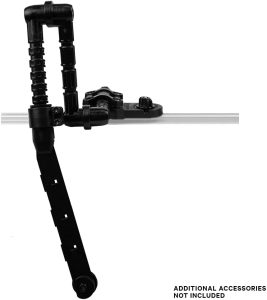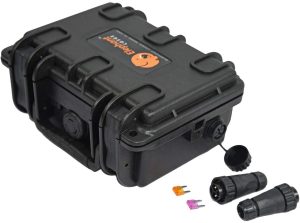Kayak fishing can be an extremely productive method for fishing. As with any other methods of fishing, a fish finder can greatly increase the odds for success. Some high end kayaks will come with fish finder setups on them already, and nearly any kayak can be fitted with a fish finder. In this article, we are going to discuss those both DIY setups, and pre-made setups so you can find the best fish finder for your kayak.
Quick Navigation:
Installation Components | Main Screen | Transducer | Power Source | Benefits Of Kayak Fish Finders
Installing A Fish Finder On A Kayak
There are three main considerations before installing a fish finder on a kayak:
- Where to mount the main screen
- Where to mount the transducer
- Where to store the power source for the fish finder
If you consider these three main elements, you can create an ideal setup for your needs. Some kayaks come pre-loaded with fish finders, or at least space to mount and store all three pieces as well.
Where To Mount Each Piece
Main Screen
Fish finders will always come with a mount. In some cases, this mount will be suitable if you have a flat section on the deck of your kayak to fit this. Sometimes these mounts are too large to fit on your particular kayak model, and therefore, it is best to buy an aftermarket mount to mount on the deck, on your kayak slide tracks, or on a swing arm that you can easily move in and out of a great position.
Here is an example of an after-market fish finder mount with a smaller footprint.
Screens are often mounted between the legs for easy viewing and operation. Many anglers may choose to place the screen mount on the slide tracks or a swing arm as these solutions allow anglers to position the screen in a perfect spot, and easily move it out of the way when necessary.
Transducer

A Transducer arm like this one from YakAttack will fit just about any kayak and just about any transducer on the market.
The transducer is what sends the sonar through the water and reads the return signal. There are a few different ways to mount the transducer, but the best method depends upon the kayak.
You may find kayaks that have a transducer recess under the hull. Kayaks with this feature will have specific transducer compatibility that should be checked before purchasing a transducer.
If your kayak doesn’t have this section, purchasing a kayak transducer mount is the way to go. There are a variety of relatively inexpensive mount systems that work quite well.
Here is an example product and installation video:
See This Transducer Mount On Amazon
Power Source
 Fish finders utilize 12V batteries to run. Most anglers use a rechargeable SLA battery to power their setup.
Fish finders utilize 12V batteries to run. Most anglers use a rechargeable SLA battery to power their setup.
This battery needs to be stored in a waterproof compartment. This compartment can be a DIY solution, or a purchased solution. On Amazon, you can find some great relatively inexpensive options. See examples here.
A DIY solution can be created utilizing some type of waterproof box, well cut holes, and waterproof sealant. Anglers may also use plastic bags, or waterproof bags to accomplish the same results with an even more budget solution.
Benefits Of A Fish Finder Setup For Your Kayak
Wondering about some of the reasons you should invest in a fish finder for your kayak? Here they are:
Find Fish Depths
Utilizing a fish finder allows you to determine the depths at which you are marking fish. This will allow you to better set up your rigs and fish at these same depths. Knowing the depths fish are currently feeding at will result in more fish. You can identify bait fish depth, as well as the fish you may be targeting.
Know Bottom Structures
Knowing the location of structures enables you to fish areas that may be feeding in and around structures. It will also enable you to avoid snags. Fish finders make finding these structures far easier.
Know Water Temperatures
Water temps are an important factor in understanding fish activity. Knowing the current temperatures may dictate the lures and bait you use as well as depth, retrieval methods, and other factors. Therefore, knowing temperatures and reacting appropriately to those temperatures may yield more fish.
Navigation
Sometimes when on a kayak, you can cover several miles. It may be difficult to track your way home, or make it to the location of your intention. A GPS device, like that on a fish finder can allow you to navigate to specific locations.
Mark Your Fishing Spots
This feature ties closely to navigation, but fish finders allow anglers to mark any spot and easily navigate to it.
Max DesMarais is the founder of hikingandfishing.com. He has a passion for the outdoors and making outdoor education and adventure more accessible. Max is a published author for various outdoor adventure, travel, and marketing websites. He is an experienced hiker, backpacker, fly fisherman, backcountry skier, trail runner, and spends his free time in the outdoors. These adventures allow him to test gear, learn new skills, and experience new places so that he can educate others. Max grew up hiking all around New Hampshire and New England. He became obsessed with the New Hampshire mountains, and the NH 48, where he guided hikes and trail runs in the White Mountains. Since moving out west, Max has continued climbed all of the Colorado 14ers, is always testing gear, learning skills, gaining experience, and building his endurance for outdoor sports. You can read more about his experience here: hikingandfishing/about
